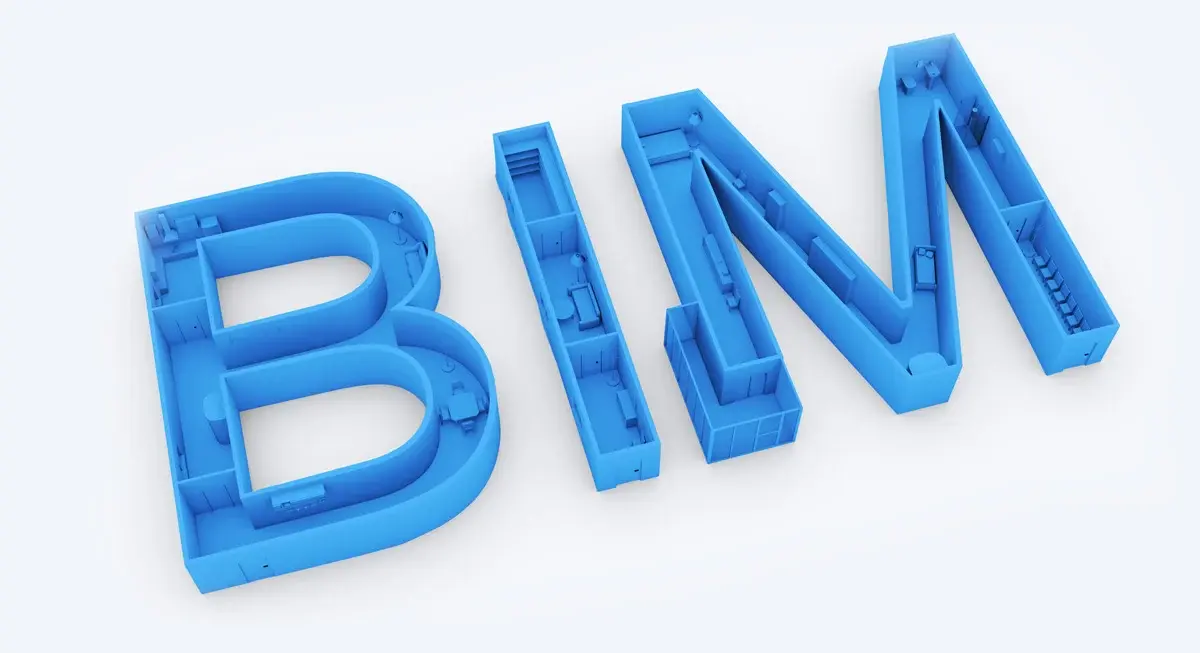
Think revolutionary. Think seamless. Think efficient.
Wondering, what comes to mind?
It's Building Information Modelling (BIM), as this is what this technology/digital platform/visualisation tool stands for.
For many AEC professionals, it’s not just a tool but a new way of working.
Let’s read in detail what BIM stand for.
What is Building Information Modelling (BIM)?
BIM, or Building Information Modelling, is a process for building a virtual model of an AEC (Architecture, Engineering, and Construction) project before starting construction.
BIM has taken the AEC industry by storm, no question about it.
That’s because an all-inclusive approach is used to design, document, and manage AEC projects. It is helping professionals to work remotely with improved project management and execution.
But how does it work?
BIM uses 3D models as a central storage for data, which helps in planning, designing, constructing, and managing the project.
Here’s a little fun fact: BIM concepts have been around since the 1950s!
Importance of Building Information Modelling
Walls, doors, windows, you name it - everything is represented as individual elements and is developed as 3D elements with BIM.
This is why the importance of BIM lies in its seamlessness. It allows professionals to participate in the design, analysis, and exploration of the project digitally. Plus, the fact that it costs significantly less doesn’t hurt either!
We’re not done raging about the benefits of BIM just yet.
Here are some more ways in which it holds importance:
1. Collaboration:
The convenience of sharing data in real time leads to uninterrupted coordination amongst stakeholders and far fewer errors.
2. Accurate Visualisation:
With BIM, you can create a 3D model of the building, which provides better visualisation by identifying problem areas easily.
3. Better Project Management:
BIM provides tools for estimating cost, budgeting, and tracking the progress of the project, which offers better control and decision-making.
4. Sustainability:
BIM can be used to monitor the environmental impact that the building will have. This promotes sustainable design and construction norms.
We’ve covered what the importance of Building Information Modelling is; Now, let’s move ahead to which sectors it’s used in.
BIM for Architecture

Gone are the days when architects had to spend hours drawing their designs by hand. BIM for architects has been a game changer. In many countries, the Government is mandating BIM-integrated projects. This is why architecture firms are now replacing CAD with BIM.
Some benefits of BIM for Architects include:
1. Shorter Project Duration: Since you can begin with the pre-construction phase of the project with the help of 4D modelling, the turnaround time cuts down significantly.
2. Scope for Pre-fabrication: With the BIM software, you can create detailed production models, which are then used for the pre-fabrication of the project.
3. Better Results: Because of detailed calculations, achieving a detailed and accurate model of the project is well within reach. This results in a higher quality of the final result. Moreover, it helps in communicating your project vision, which may result in bringing more clients.
The scope of professional development is endless in the AEC industry once you’ve a BIM certificate. So, if you would like to be a part of the change, you could begin with the upskilling route. This is where Novatr’s BIM Professional Course for Architects comes in.
Why is it worth your time?
- Mentors who have 10+ years of industry experience.
- Learn 12+ software and BIM workflows that enable you to stay up-to-date.
- Capstone projects to outshine your peers in terms of your portfolio.
- A gamified platform for not a single day of dull learning.
Job Opportunities Post Completing the Course
1. BIM Modeller:
This career path is open for freshers as well as experienced architects. All you need is a bachelor’s degree, a certificate course or basic-level knowledge of BIM. You’ll have to work in teams daily. These tasks can vary from 2D drawings to refining models.
Salary Range - INR 2 Lakh - INR 8.8 Lakh/Year
2. BIM Designer:
BIM designing consists of everything from schematic to as-built drawings, BIM designers typically take tasks from BIM managers and project managers. They are also responsible for training BIM modellers simultaneously.
Salary Range - INR 2.6 Lakh - INR 11 Lakh/Year
3. BIM Manager:
Once someone has completed 5-7 years in the field of BIM, they can transition into a managerial role. BIM Managers are assign with tasks to BIM designers and modellers and oversee their outputs.
Salary Range - INR 6.6 Lakh - INR 30.5 Lakh/Year
4. BIM Facilitator:
Since the AEC industry is so vast, there are many people who aren’t aware of the way BIM processes work. This is where BIM facilitators come in. They are specialists who form a link between people from the BIM industry as well as other sectors.
Salary Range: INR 8 Lakh/Year
5. BIM Analyst:
BIM Models are loaded with data if modelled correctly. This data goes through multiple levels of analysis. BIM Analysts are responsible for its fundamental analysis.
Salary Range: INR 3.4 Lakh/Year - INR 17.8 Lakh/Year
Now, moving on to...
BIM for Civil and Structural Engineering
BIM has significantly transformed construction, it has changed the way Civil Engineering works. Instead of having to work on heaps of paper, Civil Engineers now create detailed 3D models. This includes everything from roads, pipes, and bridges. It’s all in one place.
Some of the most popular and best BIM software for civil engineers include Bentley MicroStation, Tekla Structures, and Revit.
Benefits of BIM for Civil and Structural Engineers include:
- Clash Detection and Conflict Resolution: BIM software includes clash detection that can automatically identify discrepancies amongst design elements. This can resolve issues in plumbing and electrical systems, structural components, etc.
- Accurate Documentation: BIM for Civil and Structural Engineers makes the documentation process a breeze. People working in the field can now automatically create documents such as drawings or reports from the digital model. No more hefty paperwork!
- Compliance and Regulations: The BIM software includes features that keep the engineers in check with the local building codes. This removes any scope of risks related to non-compliance.
Want to ride this BIM wave? There's no limit to where you can go in the AEC industry once you've got those BIM skills under your belt. If you're ready to jump in, Novatr's BIM Professional Course for Civil Engineers can be your starting point. It's designed specifically to help you level up without feeling overwhelmed.
Here’s why it’s worth your time:
- Study a curriculum vetted by 200+ industry experts.
- Learn 12+ software and workflows that enable you to stay up-to-date.
- Gain hands-on experience with industry-ready tools such as Autodesk Construction Cloud (ACC), 4D, 5D BIM and more.
Job Opportunities Post Completing the Course
1. BIM Coordinator:
A BIM Coordinator makes sure that all data relating to the project is correct. They work cross-functionally, resolve conflicts, and resolve design discrepancies.
Salary Range - INR 4 Lakh - INR 24 Lakh/Year
2. Clash Detention Specialist:
Clash detection is a very important process in BIM. Hence, Civil Engineers who work in this area are required to use tools such as Navisworks. These specialists make sure that there are no conflicts when it comes to the performance of the project.
Salary Range - INR 4 Lakh - INR 6 Lakh/Year
3. Infrastructure BIM Specialist:
Projects like building highways, railroads, and bridges are now completed with BIM. BIM helps civil and structural engineers to work on these projects in a smooth and efficient manner. This role mainly requires managing bandwidths, and timelines, and minimising costs.
Salary Range - INR 8 Lakh - INR 12 Lakh/Year
4. BIM Project Manager:
A BIM Project Manager’s day-to-day tasks include implementing BIM on projects, collaborating with all stakeholders and making sure that the data is managed effectively.
Salary Range: INR 6 Lakh/Year - INR 12 Lakh/Year
And last, but not least…
BIM for MEP Engineers

In today’s job market, MEP engineers are juggling an overwhelming set of requirements. Some are having to create high-performing systems that won't break the project budget and can be built in the real world. No pressure, right?
This is exactly where BIM for MEP Engineers comes in. It helps teams collaborate like never before, makes sustainable choices clearer, and pushes the boundaries of what's possible, all while keeping you ahead of the competition.
Some benefits of BIM for MEP Engineering:
- Design Accuracy: Detailed 3D modelling can be achieved through BIM to create MEP systems such as HVAC, plumbing and electrical layouts. This helps engineers create simulations that can help improve energy usage.
- Resource Management: BIM improves cost efficiency and material utilisation significantly. This helps professionals to maximise wire, pipe, and duct routes.
- Optimised Timeline: Since BIM software provides 4D modelling, it reduces the journey from pre-construction to completion.
Long story short, BIM opens doors to a better experience while you’re building an AEC project. If this is something that sounds interesting to you, you can begin with upskilling. Novatr's BIM Professional Course for MEP Engineers cuts through the competition and gives you exactly what you need to get started.
No fluff, just practical skills that employers are looking for.
What sets it apart?
- 1000+ Novatr alumni have witnessed significant career growth after the MEP program completion.
- The top 20% of Novatr graduates secured positions in Tier A companies.
- Learn 12+ software and plugins
- Get the opportunity to work on 3+ ISO Certified Projects
Job Opportunities Post Completing the Course
1. BIM MEP Engineer:
A BIM MEP Engineer works on designing and coordinating the project with the help of the comprehensive BIM process.
Salary Range - INR 2.5 Lakh - INR 11 Lakh/Year
2. BIM Specialist/Technician:
A BIM Specialist/Technician supports MEP design and documentation with the help of BIM software.
Salary Range - INR 3.4 Lakh - INR 17.9 Lakh/Year
3. BIM Design Engineer:
This role consists of the person using the BIM software to design and replicate MEP systems.
Salary Range - INR 2.2 Lakh - INR 10.1 Lakh/Year
4. Revit MEP Modeller:
The role of a Revit MEP Modeller is to create complex 3D representations of MEP systems.
Salary Range - INR 2.1 Lakh - INR 8.9 Lakh/Year
P.S. If listening is your thing, you might want to check out: An interview with Novatr, Ar. Harsha Vinjam, the BIM Professional Course mentor, talked about the importance of BIM in the AEC industry and how it helps him design sustainable buildings.
Most Popular Building Information Modelling (BIM) Software For AEC Professionals

The industry is going fast, and so are the skills required for AEC professionals. As the list of software you should be well-versed with grows longer, here are a few that you should begin with:
|
BIM Software |
Used by |
Key Use |
|
Revit |
Architects, Civil Engineers, and MEP Engineers |
|
|
Navisworks |
Architects, Civil Engineers, and MEP Engineers |
|
|
BIM 360 |
Architects, Engineers, Contractors, and Project Owners |
|
|
FormIt |
Architects, Designers, and Engineers |
|
|
Infraworks |
Civil Engineers and Civil Designers |
|
|
cove.tool |
Architects, Civil Engineers, and Construction Engineers |
|
|
Twinmotion |
Architects and Designers |
|
|
Archicad |
Architects and BIM Managers |
|
A bit more about this software to get you acquainted with exactly what you’re signing up for:
1. Revit:
One of the most well-known software programs in the industry, Revit has a lot of features that work well for all stakeholders in the industry. Revit can work through all stages of the design as well as documentation.
2. Navisworks:
Commonly known as the BIM software used to review 3D models, Navisworks gives a holistic view of the project planning, including the eventual outcome.
3. BIM 360:
BIM 360 is ideal for integrating BIM and non-BIM software. This software improves the completion cycle of the project by giving ownership to all stakeholders.
4. Formit:
This BIM software is a sketching and massing tool used for conceptual design.
5. Infraworks:
This could be a common name among Civil Engineers. This is one of the most used BIM software programs from Autodesk in the AEC industry. It allows the inclusion of data from other CAD and 3D models, BIM-GIS, CityGML as well as satellite imagery.
6. Cove.tool:
This is a design analysis platform used for the design process of intelligent building performance. It mainly focuses on sustainability and efficiency.
7. Twinmotion:
This BIM software is a real-time visualisation tool from Epic Games. It can convert BIM models into high-quality renders, animations and VR videos.
8. Archicad:
Commonly known as the first BIM software for commercial use since 1987. It can support a light operating system and provides a streamlined workflow.
But enough rambling about the industry and the software. Where does it all lead to? Yes, the industry is thriving right now, but will it continue to?
Conclusion
BIM was the second most requested skill that AEC firms require from their workforce. So, it’s safe to say that the already growing demand is going to take the upward trajectory of demand.
The AEC industry has to face a reality check. Upskilling and getting a better grip on the BIM software means that Architects, Civil Engineers and MEP Engineers can do more. If you're just starting your career, getting comfortable with BIM tools early is non-negotiable.
It's all about embracing the change and using it to make ourselves more valuable, not fighting against the inevitable. Novatr is leading this change.
Take the next step in your career today! Go through our Resource Page for the latest industry insights and updates.
Was this content helpful to you

TABLE OF CONTENTS









